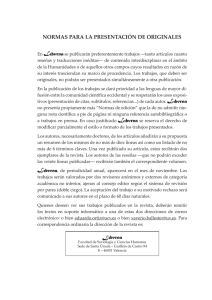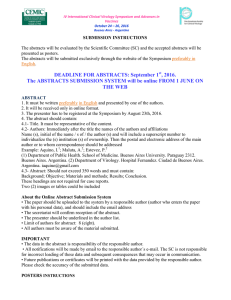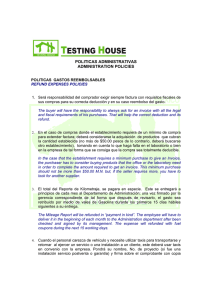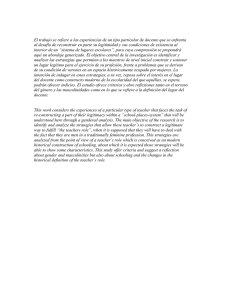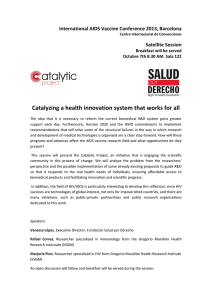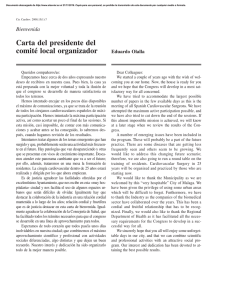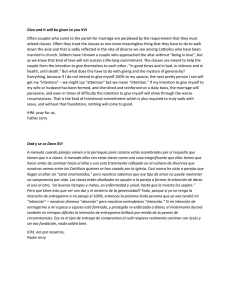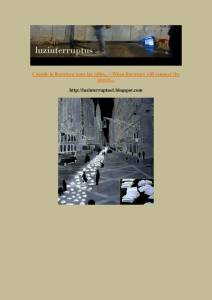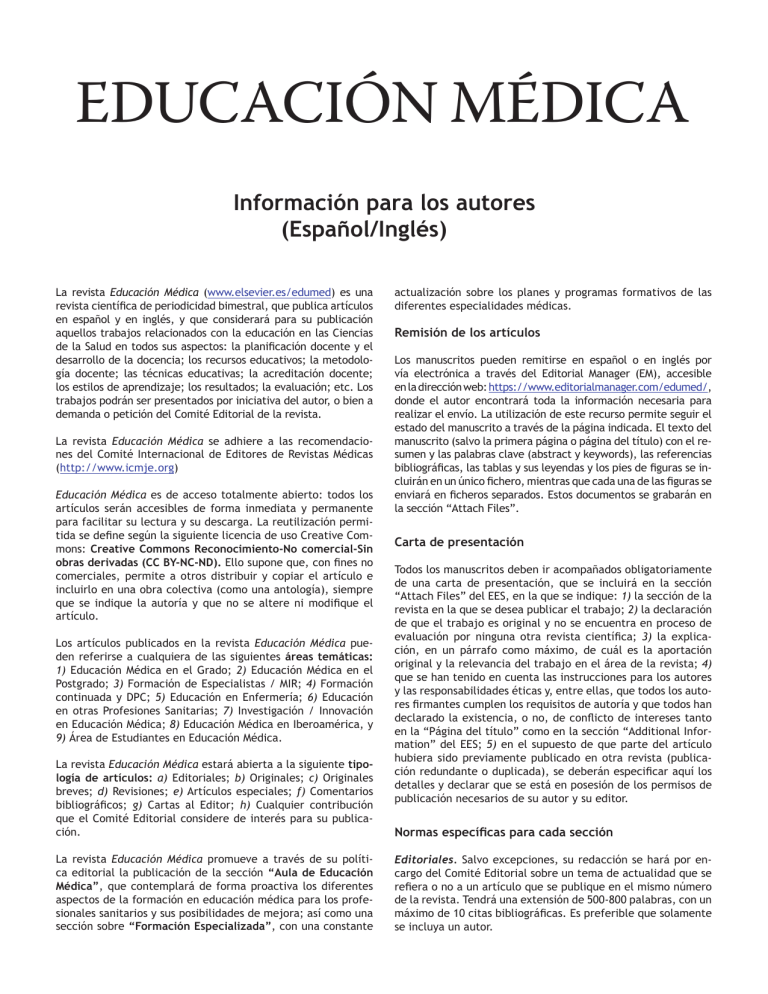
EDUCACIÓN MÉDICA Información para los autores (Español/Inglés) La revista Educación Médica (www.elsevier.es/edumed) es una revista científica de periodicidad bimestral, que publica artículos en español y en inglés, y que considerará para su publicación aquellos trabajos relacionados con la educación en las Ciencias de la Salud en todos sus aspectos: la planificación docente y el desarrollo de la docencia; los recursos educativos; la metodología docente; las técnicas educativas; la acreditación docente; los estilos de aprendizaje; los resultados; la evaluación; etc. Los trabajos podrán ser presentados por iniciativa del autor, o bien a demanda o petición del Comité Editorial de la revista. La revista Educación Médica se adhiere a las recomendaciones del Comité Internacional de Editores de Revistas Médicas (http://www.icmje.org) Educación Médica es de acceso totalmente abierto: todos los artículos serán accesibles de forma inmediata y permanente para facilitar su lectura y su descarga. La reutilización permitida se define según la siguiente licencia de uso Creative Commons: Creative Commons Reconocimiento-No comercial-Sin obras derivadas (CC BY-NC-ND). Ello supone que, con fines no comerciales, permite a otros distribuir y copiar el artículo e incluirlo en una obra colectiva (como una antología), siempre que se indique la autoría y que no se altere ni modifique el artículo. Los artículos publicados en la revista Educación Médica pueden referirse a cualquiera de las siguientes áreas temáticas: 1) Educación Médica en el Grado; 2) Educación Médica en el Postgrado; 3) Formación de Especialistas / MIR; 4) Formación continuada y DPC; 5) Educación en Enfermería; 6) Educación en otras Profesiones Sanitarias; 7) Investigación / Innovación en Educación Médica; 8) Educación Médica en Iberoamérica, y 9) Área de Estudiantes en Educación Médica. La revista Educación Médica estará abierta a la siguiente tipología de artículos: a) Editoriales; b) Originales; c) Originales breves; d) Revisiones; e) Artículos especiales; f) Comentarios bibliográficos; g) Cartas al Editor; h) Cualquier contribución que el Comité Editorial considere de interés para su publicación. La revista Educación Médica promueve a través de su política editorial la publicación de la sección “Aula de Educación Médica”, que contemplará de forma proactiva los diferentes aspectos de la formación en educación médica para los profesionales sanitarios y sus posibilidades de mejora; así como una sección sobre “Formación Especializada”, con una constante actualización sobre los planes y programas formativos de las diferentes especialidades médicas. Remisión de los artículos Los manuscritos pueden remitirse en español o en inglés por vía electrónica a través del Editorial Manager (EM), accesible en la dirección web: https://www.editorialmanager.com/edumed/, donde el autor encontrará toda la información necesaria para realizar el envío. La utilización de este recurso permite seguir el estado del manuscrito a través de la página indicada. El texto del manuscrito (salvo la primera página o página del título) con el resumen y las palabras clave (abstract y keywords), las referencias bibliográficas, las tablas y sus leyendas y los pies de figuras se incluirán en un único fichero, mientras que cada una de las figuras se enviará en ficheros separados. Estos documentos se grabarán en la sección “Attach Files”. Carta de presentación Todos los manuscritos deben ir acompañados obligatoriamente de una carta de presentación, que se incluirá en la sección “Attach Files” del EES, en la que se indique: 1) la sección de la revista en la que se desea publicar el trabajo; 2) la declaración de que el trabajo es original y no se encuentra en proceso de evaluación por ninguna otra revista científica; 3) la explicación, en un párrafo como máximo, de cuál es la aportación original y la relevancia del trabajo en el área de la revista; 4) que se han tenido en cuenta las instrucciones para los autores y las responsabilidades éticas y, entre ellas, que todos los autores firmantes cumplen los requisitos de autoría y que todos han declarado la existencia, o no, de conflicto de intereses tanto en la “Página del título” como en la sección “Additional Information” del EES; 5) en el supuesto de que parte del artículo hubiera sido previamente publicado en otra revista (publicación redundante o duplicada), se deberán especificar aquí los detalles y declarar que se está en posesión de los permisos de publicación necesarios de su autor y su editor. Normas específicas para cada sección Editoriales. Salvo excepciones, su redacción se hará por encargo del Comité Editorial sobre un tema de actualidad que se refiera o no a un artículo que se publique en el mismo número de la revista. Tendrá una extensión de 500-800 palabras, con un máximo de 10 citas bibliográficas. Es preferible que solamente se incluya un autor. Información para los autores Originales. Artículos de investigación o innovación sobre educación en Ciencias de la Salud. Deberán seguir el formato de: Introducción, Material y métodos, Resultados y Discusión. La extensión máxima del texto será de 2.000 palabras (incluidos resumen y abstract), con un máximo de 30 citas bibliográficas, y se admitirán hasta 3 figuras o tablas. Es indispensable incluir un resumen y abstract estructurados, con una extensión no superior a las 250 palabras. El contenido del resumen se estructurará en cuatro epígrafes: Introducción, Métodos, Resultados y Conclusión. Tras el resumen se incluirán de 3 a 8 palabras clave y keywords. El número máximo de autores será de 8. En caso de manuscritos con más de 8 autores, se deberá justificar la razón en la carta de presentación al Comité Editorial. Originales breves. Estos artículos deberán seguir el formato de la sección “Originales” y tener una extensión máxima de 800 palabras (incluidos resumen y abstract), con un máximo de 5 referencias bibliográficas y se admitirán hasta 2 tablas o figuras. Es indispensable incluir un resumen y abstract estructurados, con una extensión no superior a las 150 palabras. El contenido del resumen se estructurará en cuatro epígrafes: Introducción, Métodos, Resultados y Conclusión Tras el resumen se incluirán de 3 a 5 palabras clave y keywords. El número máximo de autores será de 8. Revisiones. Su redacción será por encargo del Comité Editorial, y se incluirán artículos que se centren en temas de actualidad sobre la educación en las Ciencias de la Salud. La extensión máxima del texto será de 2.000 palabras (incluidos resumen y abstract), con un máximo de 30 citas bibliográficas, y se admitirán hasta 2 figuras o tablas. Es indispensable incluir un resumen y abstract sin estructurar, con una extensión no superior a las 200 palabras. Tras el resumen se incluirán entre 3 y 8 palabras clave y keywords. El número máximo de autores será de 4. Artículos especiales. Su redacción será por encargo del Comité Editorial, y se incluirán artículos relacionados con la educación en las Ciencias de la Salud. La extensión máxima del texto será de 2.000 palabras (incluidos resumen y abstract), con un máximo de 30 citas bibliográficas, y se admitirán hasta 2 figuras o tablas. Es indispensable incluir un resumen y abstract sin estructurar, con una extensión no superior a las 200 palabras. Tras el resumen se incluirán entre 3 y 6 palabras clave y keywords. El número máximo de autores será de 8. Comentarios bibliográficos. En esta sección se publicarán breves análisis del contenido y la relevancia de un libro o informe publicado recientemente en el ámbito de la educación en las Ciencias de la Salud, con la finalidad de orientar a los lectores sobre los textos o documentos que pueden ser de su interés. Este tipo de contribuciones tendrán una extensión máxima de 400 palabras y deben incluir: 1) Autor/ es, título, lugar de edición, editorial, ISBN, depósito legal y número de páginas; 2) resumen de contenidos y objetivos generales planteados por los autores; 3) principales fortalezas y debilidades del documento; 4) información adicional que quiera destacarse. Cartas al Editor. El Comité Editorial anima a los lectores de Educación Médica a que remitan comentarios, consideraciones u objeciones relativos a artículos publicados recientemente en la revista y, en algunos casos, sobre artículos relevantes publicados en otras revistas. La extensión máxima será de 300 palabras. Preparación del artículo Primera página La primera página del texto debe incluir: • Título del trabajo en español e inglés. • Título abreviado en español e inglés (máximo: 40 caracteres). • Autores: se indicará el nombre y uno o dos apellidos de todos los autores en el orden en que deseen aparecer en el artículo. Se debe tener en cuenta que el formato que los autores elijan para su firma será, en caso de publicación del artículo, el mismo que se indexará en las distintas bases de datos bibliográficas en las que la revista esté incluida. El número máximo dependerá de la sección de la revista. • Centro de trabajo de todos y cada uno de los autores. • Persona designada para mantener la correspondencia relacionada con el trabajo, indicando una dirección postal y electrónica. • Palabras clave en español e inglés (mínimo y máximo como indicado). • Fuente de financiación del trabajo, si procede. • Otra información relevante sobre el trabajo, si procede. Por ejemplo, si ha sido presentado previamente en una jornada congreso, si ha recibido algún premio... Tablas y figuras Las figuras se presentarán separadamente del texto del artículo, cada una en una página o fichero electrónico independiente. La numeración de tablas y figuras debe realizarse separadamente y en números arábigos. Las tablas deben aparecer al final del texto, tras la bibliografía y deben ser lo más sencillas posible y no duplicar información que se presenta en el texto. Deben ser autoexplicativas, con un título breve que describa su contenido. Su estructura debe ser lo más simple posible y presentar la información en una secuencia lógica, lo que habitualmente significa ordenarla de izquierda a derecha y de arriba hacia abajo. Las filas y columnas deben ir precedidas de un encabezamiento corto o abreviado, que identifique exactamente el material que contiene. Si la tabla ocupa más de una página, los encabezamientos deben repetirse en cada una de ellas. Debe mantenerse coherencia en la puntuación o abreviaturas de las palabras, o en las unidades de medida o decimales de los datos numéricos. Es recomendable presentar solamente los dígitos significativos y hacerlo únicamente con un decimal. En caso de utilizarse abreviaturas o símbolos, si no son autoexplicativos, deben hacerse explícitos mediante el uso de notas a pie de tabla. Si se incluyen datos que no proceden del estudio, debe señalarse claramente con una nota al pie de tabla que identifique la fuente. Cuando se presenta más de una tabla, es conveniente utilizar un formato similar para facilitar su comprensión al lector. Debe comprobarse que todas las tablas aparecen mencionadas en el texto, y que los datos que se presentan concuerdan con los que se citan. Las figuras deben utilizarse solamente cuando la información no pueda presentarse claramente de otra forma. No deben repetirse en gráficos los datos ya presentados en las tablas o el texto. Información para los autores En la elaboración de los gráficos debe tenerse un especial cuidado en no distorsionar lo que se pretende mostrar, ya que la presentación visual puede inducir al lector a una interpretación errónea. Las escalas de medida deben estar claras y ser consistentes. Se considerarán figuras las fotografías, gráficos de datos y esquemas. Cada una irá en un archivo aparte preferiblemente en formato JPG o TIFF. Las fotografías se seleccionarán cuidadosamente, omitiendo las que no contribuyan a una mejor comprensión del texto. Es importante que la copia sea de la mejor definición posible (300 ppp), para asegurar la calidad de la reproducción. Se deben incluir los pies de figura, en una página aparte, al final del manuscrito, tras la bibliografía o tras las tablas, si las hubiera, con la numeración arábiga que corresponda a la figura. Si se reproducen fotografías o datos de pacientes, estos no deben ser identificativos del sujeto. En todos los casos, los autores deben haber obtenido el consentimiento informado escrito del paciente que autorice su publicación, reproducción y divulgación en soporte papel y en Internet en Educación Médica. Asimismo, los autores son responsables de obtener los oportunos permisos para reproducir en Educación Médica material (texto, tablas o figuras) publicado previamente. Estos permisos deben solicitarse tanto al autor como a la editorial que ha publicado dicho material. Educación Médica en su versión impresa, publica todas las figuras en escala de grises y en su versión electrónica a color sin coste adicional. Cuando se desee la publicación en la versión impresa de la revista de fotografías en color, los gastos correrán a cargo del autor, que solicitará presupuesto a la Editorial. Agradecimientos Sólo se expresarán a las personas o entidades que hayan contribuido notoriamente a hacer posible el trabajo: a) las contribuciones que deben ser agradecidas pero no justifican la inclusión como autor, y b) el agradecimiento por ayuda técnica que debe ser reconocida en un párrafo distinto. Todas las personas mencionadas específicamente en “Agradecimientos” deben conocer y aprobar su inclusión en dicho apartado. Bibliografía Las referencias bibliográficas deben numerarse consecutivamente en el orden en que aparecen por primera vez en el texto. Las referencias deben ser lo más recientes y relevantes posible, y escritas cuidadosamente según el formato Vancouver (www.nlm.nih.gov/citingmedicine). Obligaciones del autor Responsabilidades éticas Protección de personas y animales. Cuando se describen experimentos que se han realizado en seres humanos se debe indicar si los procedimientos seguidos están conforme a las normas éticas del comité de experimentación humana responsable (institucional o regional) y de acuerdo con la Asociación Médica Mundial y la Declaración de Helsinki disponible en: http://www.wma.net/en/30publications/10policies/b3/. Cuando se describan experimentos en animales se debe indicar si se han seguido las pautas de una institución o consejo de investigación internacional o una ley nacional reguladora del cuidado y la utilización de animales de laboratorio. Confidencialidad. Los autores son responsables de seguir los protocolos establecidos por sus respectivos centros sanitarios para acceder a los datos de las historias clínicas a los fines de poder realizar este tipo de publicación con finalidad de investigación/divulgación para la comunidad por lo que deberán declarar el cumplimiento de esta exigencia. El autor tiene la obligación de garantizar que se ha cumplido la exigencia de haber informado a todos los pacientes incluidos en el estudio y que está en posesión del documento firmado por éstos de haber recibido información suficiente y de haber obtenido su consentimiento informado por escrito para participar en el mismo. Los autores deben mencionar en el apartado “Métodos” que los procedimientos utilizados en los pacientes y controles han sido realizados tras obtención de un consentimiento informado. Privacidad. El autor es responsable de garantizar asimismo el derecho a la privacidad de los pacientes protegiendo su identidad tanto en la redacción de su artículo como en las imágenes. No utilizará nombres, iniciales o números de historia clínica del hospital (o cualquier otro tipo de dato irrelevante para la investigación que pudiera identificar al paciente) ni en el texto, ni en las fotografías, a menos que dicha información sea esencial para los objetivos científicos, en cuyo caso podrá recogerla en el artículo siempre que el paciente o su progenitor o tutor dé el consentimiento informado por escrito para su publicación. Los autores son responsables de la obtención del consentimiento informado por escrito, autorizando su publicación, reproducción y divulgación en soporte papel e internet de libre acceso en Internet. Financiación Los autores deberán declarar la procedencia de cualquier ayuda económica recibida. Los autores deberán reconocer si la investigación ha recibido financiación de los US National Institutes of Health o si alguno de los autores pertenece al Howard Hughes Medical Institute. Autoría En la lista de autores deben figurar únicamente aquellas personas que han contribuido intelectualmente al desarrollo del trabajo. Haber ayudado en la colección de datos o haber participado en alguna técnica no son por sí mismos criterios suficientes para figurar como autor (véase “Agradecimientos”). En general, para figurar como autor se deben cumplir los siguientes requisitos: 1. Haber participado en la concepción y diseño, la adquisición de los datos, el análisis e interpretación de los datos del trabajo que ha dado como resultado el artículo en cuestión. 2. Haber participado en la redacción del texto y en las posibles revisiones del mismo. 3. Haber aprobado la versión que finalmente va a ser publicada. En caso de autoría colectiva, se incluirá el nombre de los redactores o responsables del trabajo seguido de «y el Grupo…» cuando todos los miembros del grupo se consideren coautores del trabajo. Si se desea incluir el nombre del grupo, aunque no todos sus miembros sean considerados coautores, la fórmula utilizada será mencionar los autores responsables seguido de «en nombre del Grupo…» o «por el Grupo…». En cualquier caso, los nombres e instituciones de los miembros del grupo se incluirán en un anexo al final del manuscrito. Los autores se harán constar tanto en la primera página del título como en la sección Add/Edit/Remove/Author. Declaración de que han leído y aprobado el manuscrito y que los requisitos para la autoría se han cumplido. Información para los autores La revista declina cualquier responsabilidad sobre posibles conflictos derivados de la autoría de los trabajos que se publican en la revista. Conflicto de intereses Existe un conflicto de intereses cuando el autor tuvo/tiene relaciones económicas o personales que han podido sesgar o influir inadecuadamente sus actuaciones. El potencial conflicto de intereses existe con independencia de que los interesados consideren que dichas relaciones influyen o no en su criterio científico. Los autores describirán en la Carta de presentación y en la sección Additional information del EES cualquier relación financiera o personal que tuvieran o tengan, en el momento de escribir o remitir el artículo con personas o instituciones y que pudieran dar lugar a un conflicto de intereses en relación con el artículo que se remite para su publicación. Lo que se declare se hará constar en la revista impresa (véase también el apartado “Agradecimientos”). Obtención de permisos Los autores son responsables de obtener los oportunos permisos para reproducir parcialmente material (texto, tablas o figuras) de otras publicaciones. Estos permisos deben solicitarse tanto al autor como a la Editorial que ha publicado dicho material. Se requiere permiso de publicación por parte de la institución que ha financiado la investigación. Declaración de que el contenido del artículo es original y que no ha sido publicado previamente ni está enviado ni sometido a consideración a cualquier otra publicación, en su totalidad o en alguna de sus partes. Los autores deben ser conscientes que no revelar que el material sometido a publicación ha sido ya total o parcialmente publicado constituye un grave quebranto de la ética científica. Del mismo modo, los autores que reproduzcan en su artículo materiales publicados previamente (texto, tablas o figuras) son los responsables de obtener los oportunos permisos para reproducir en la revista dichos materiales. Los autores deberán haber obtenido autorización escrita tanto del autor como de la editorial que ha publicado este material y remitir copia de las mismas junto con el artículo a la revista. Publicación redundante o duplicada La revista no acepta material previamente publicado y no considerará para su publicación manuscritos que estén remitidos simultáneamente a otras revistas, ni publicaciones redundantes o duplicadas, esto es, artículos que se sobrepongan sustancialmente a otro ya publicado, impreso o en medios electrónicos. Los autores deben informar en la carta de presentación acerca de envíos o publicaciones previas del mismo trabajo, en su totalidad o parcialmente, que puedan considerarse publicación redundante o duplicada. Es necesario citar e incluir la referencia bibliográfica de estas publicaciones previas en el nuevo manuscrito. Estas restricciones no son aplicables a los resúmenes publicados de comunicaciones, ponencias o conferencias presentados en reuniones científicas nacionales o internacionales. EDUCACIÓN MÉDICA Instructions for Authors The Journal Educación Médica (Medical Education) (www. elsevier.es/edumed) is a scientific journal that is published 6 times a year, with articles in Spanish and in English, and will consider for publication those works related to education in the Health Sciences in all its aspects: teaching planning, and development of teaching; educational resources; teaching methodology; educational techniques; teaching accreditation; learning styles results; evaluation; etc. Works may be submitted on the initiative of the author, or at the request or commission of the journal Editorial Committee. The journal Educación Médica adheres to the recommendations of the International Committee of Medical Journal Editors (http://www.icmje.org) Educación Médica is completely open access: all articles will be accessible immediately and permanently, so that they may be easily read and downloaded. The permitted reuse is defined by the following Creative Commons use license: Creative Commons Attribution-Non Commercial-No Derivatives (CC BY-NC-ND). This means that, for non-commercial purposes, it allows others to distribute and copy the article to include in a collective work (such has an anthology), provided that it mentions the author, and that it does not change or modify the article. Articles published in Educación Médica may refer to any of the following subject areas: 1) Undergraduate Medical Education; 2) Post-graduate Medical Education; 3) Specialist / Internal Resident Training; 4) Continuing Education and Continuing Professional Development; 5) Education in Nursing; 6) Education in other Health Professionals; 7) Research / Innovation in Medical Education; 8) Medical Education in Ibero-America, and 9) Students Area in Medical Education. Educación Médica will be open to the following types of articles: a) Editorials; b) Originals; c) Short Originals; d) Reviews; e) Special Articles; f) Literature Comments; g) Letters to the Editor; and h) Any contribution that the Editorial Committee considers a publication of interest. Through its Editorial Policy, Educación Médica promotes the publication of the section; “Medical Education Hall”, which proactively examines the different aspects of training in medical education for health professionals and their possibilities of improvement; as well as a section on; “Specialist Training”, with a constant update on training plans and programs of the different medical specialties. Submission of articles Manuscripts, in Spanish or in English, can be submitted electronically through the Editorial Manager (EM) accessible at the web address: https://www.editorialmanager.com/ edumed/, where the author will find all information required to make the submission. The use of this resource enables the status of the manuscript to be followed via the indicated web page. The text of the manuscript (except the first page or title page) with the abstract/resumen and keywords/ palabras clave, the bibliographic references, the Tables and their legends and the figure footnotes will be included in a single file, while each one of the Figures will be submitted in separate files. These documents will be uploaded in the “Attach Files” section. Cover Letter All manuscripts must be accompanied by a mandatory Cover Letter, which should be entered in the Attach Files section of the EES, in which it should indicate: 1) The section of the journal desired for the work to be published; 2) The statement that the work is original and is not in the process of being evaluated by any other scientific journal. 3) a statement, in a maximum of one paragraph, of what the original work contributes and the relevance of the work in the field of the journal; 4) that the Instructions for Authors and the ethical responsibilities have been taken into account and, among others, that all the signing authors fulfil the authorship requirements, and that all have declared the existence, or not, of any conflict of interests on the “Title Page”, as well as in the “Additional Information” of the EES; 5) in the event that part of the article may have been previously published in another journal (redundant or duplicate publication), the details must be specified here, and a declaration that you have the necessary publication permissions from its author and its publisher. Specific instructions for each section Editorials. Apart from exceptions, these will be commissioned by the Editorial Committee, and will be on a current topic that may or may not refer to an article that is published in the same issue of the Journal. It will contain 500-800 words, and with a maximum of 10 literature references. It is preferable that it only includes one author. Instructions for Authors Originals. Articles on research or innovation in education in Health Sciences. It should follow the format of: Introduction, Material and methods, Results, and Discussion. The maximum length of text will be 2,000 words (included resumen and abstract), up to a maximum of 30 literature references, and up to 3 Tables or Figures will be accepted. It is obligatory to include a structured abstract and resumen of no more than 250 words. Between 3 and 8 key words and palabras clave will be added after the abstract and resumen. There will be maximum number of 8 authors. In the case of manuscripts with more than 8 authors, the reason should be justified in the Cover Letter to the Editorial Committee. Short Originals. These articles will follow the format of the “Originals” section and will contain a maximum of 800 words (included resumen and abstract), and with a maximum of 5 literature references, and and up to 2 Tables or Figures will be accepted. It is obligatory to include a structured abstract and resumen of no more than 150 words. The content of the abstract is structured into four subsections: Introduction, Methods, Results and Conclusion. Between 3 and 5 key words and palabras clave will be added after the abstract and resumen. The maximum number of authors will be 8. Reviews. These articles will be commissioned by the Editorial Committee, being related to education in the Health Sciences. The maximum length of text will be 2,000 words (included resumen and abstract), up to a maximum of 30 literature references, and up to 2 Tables or Figures will be accepted. It is obligatory to include a structured abstract and resumen of no more than 200 words. Between 3 and 8 key words/palabras clave will be added after the abstract/resumen. The maximum number of authors will be 4. Special Articles. These articles will be commissioned by the Editorial Committee, being related to education in the Health Sciences that, due to their characteristics, cannot be included in the “Originals” or “Reviews” sections. The maximum length of text will be 2,000 words (included resumen and abstract), up to a maximum of 30 literature references, and up to 2 Tables or Figures will be accepted. It is obligatory to include a structured abstract and resumen of no more than 200 words. Between 3 and 6 key words and palabras clave will be added after the abstract/resumen. The maximum number of authors will be 8. Literature comments. This section will publish brief analyses of the contents and relevance of a recently published book or report in the field of education in the Health Sciences, with the aim of highlighting texts or documents that may be of interest to the readers. These types of contributions will have a maximum of 400 words and must include: 1) Author/s, title, place published, publisher, ISBN, legal deposit, and number of pages; 2) a summary of the contents and general objectives approached by the author/s; 3) main strengths and weaknesses of the document; and 4) any additional information that it is wished to emphasize. Letters to the Editor. The Editorial Committee encourages the readers of Educación Médica to submit comments, considerations, or objections associated with articles recently published in the Journal and, in some cases, on relevant articles published in other journals. The maximum length will be 300 words. Preparation of the article First page (Title Page) The first page of the text must include: • Title of the work in Spanish and in English. • Short title in Spanish and in English (maximum: 40 characters). • Authors: it should indicate the name and one or two surnames of the authors in the order in which they wish to appear in the article. It should be taken into account that the format that the authors choose for their signature in the event that the article is published, will be indexed as such in the different literature databases in which the Journal is included. The maximum number will depend on the journal section. • Work center of each and every one of the authors. • Person designated for the correspondence associated with the work (Author for correspondence), indicating a postal and e-mail address. • Key words/palabras clave in English and in Spanish (minimum and maximum as indicated). • Funding source of the work, if applicable. • Other relevant information about the work, if applicable. For example, if it has been previously presented at a conference, if it has received an award… Tables and Figures The Figures will be submitted separately from the text of the article, each one on a separate page or electronic file. The numbering of the Tables and Figures must be separate and in Arabic numbers. The Tables must appear at the end of the text, after the literature references, and must be as simple as possible and not duplicate the information presented in the text. They must be self-explanatory, with a short title that describes their contents. Their structure must be as simple as possible and present the information in a logical sequence, which usually means ordered from left to right and from above to below. The rows and columns must have a short or abbreviated heading that will identify exactly the material that they contain. If a Table takes up more than one page, the headings must be repeated on each one of the pages. There must be consistency in the punctuation or abbreviations of words, or in the measurement units or decimals of numeric data. It is recommended to only present the significant digits and to only one decimal. When abbreviations or symbols are used, if they are not selfexplanatory, they must be explained using the Table footnotes. If data that are not from the study are included, it must be clearly mentioned with a Table footnote that identifies the source. When more than one Table is presented, it is advisable to use a similar format to make them more understandable to the reader. It must be checked that all the Tables appear as mentioned in the text, and that all the data presented agree with those that are mentioned. Figures must only be used when the information cannot be presented clearly in another form. Data already presented in Tables or in the text must not be repeated in graphs. Special care must be taken in the preparation of graphs, so as not to distort what it is trying to show, since visual presentation could lead to an erroneous interpretation by the reader. The measurement scales must be clear and consistent. Instructions for Authors Photographs, data graphs and diagrams will be considered as Figures. Each one will be submitted in a separate file, preferably in JPG or TIFF format. Photographs should be selected carefully, and omitting those that may not contribute to a better understanding of the text. It is important that the copy is of the best possible definition (300 dpi), to ensure the quality of the reproduction. Figure footnotes must be included on a separate page, at the end of the manuscript, after the references or after the Tables, if there are any, with Arabic numbering that corresponds to the Figure. If photographs or patient details are reproduced, these must not be able to identify the subject. In all cases, the authors must have obtained the written informed consent of the patient that authorizes their publication, reproduction and disclosure on paper support and on the internet in Educación Médica. Furthermore, the authors are responsible for obtaining the appropriate permissions to reproduce previously published material (text, Tables, or Figures), in Educación Médica. These permissions must be requested from the author, as well as from the publisher that has published that material. In its printed version, Educación Médica publishes all the Figures in gray scale, and in color in its electronic version at no additional cost. When it is wished to publish the photographs in color in the printed version of the Journal, the costs will be borne by the author, who will request an estimate from the Editorial Committee. Acknowledgements These will only be expressed to those individuals or entities that have significantly contributed to make the work possible: a) contributions that must be acknowledged but do not justify inclusion as an author, and b) acknowledgements for technical help, which must be recognized, in a separate paragraph. All persons specifically mentioned in the “Acknowledgements” must be aware of this, and approve their inclusion in this section. References The literature references must be numbered consecutively in the order in which they appear for the first time in the text, being identified with numbers in parenthesis. The references must be as recent and relevant as possible, and carefully written in the Vancouver format (www.nlm.nih.gov/ citingmedicine). Obligations of the author Ethical responsibilities Protection of human subjects and animals. When describing experiments that have been carried out on human beings it must be mentioned that the procedures followed are in accordance with the ethical guidelines of the committee responsible for human research (institutional or regional) and in accordance with the World Medical Association and the Helsinki Declaration, available at: http://www.wma.net/ en/30publications/10policies/b3/. When experiments on animals are described it must mention whether the rules of an institution or an international research council or a national regulatory law on the care and use of laboratory animals have been followed. Confidentiality. The authors are responsible for following the protocols established by their respective health centers to access data from medical records in order to write this type of publication for research / disclosure purposes for the community and thus must declare that they have complied with this requirement. The author is obliged to ensure that the requirement of having informed all the patients enrolled in the study has been met, and is in possession of the document signed by them after having received sufficient information and having obtained their written informed consent for participation in the study. The authors must mention, in the “Methods” that the procedures used in patients and controls were performed after having obtained the signed informed consent form. Privacy. The author is also responsible for ensuring the right of privacy of the patients by protecting their identity, both in the text of the article as well as in the images. Names, initials or hospital medical records numbers must not be used (or any type of details irrelevant for the study that could identify the patient) either in the text or the photographs, unless that information is essential for the scientific objectives, in which case it could be mentioned in the article provided that the patient or parent or guardian gave written informed consent for its publication. The authors are responsible for obtaining the written informed consent for their publication, reproduction and disclosure on paper support and by free internet access. Funding The authors must declare any source of any financial help received. The authors must acknowledge if the research has received funding from the US National Institutes of Health or if any of the authors belong to the Howard Hughes Medical Institute. Authorship Only those persons who have intellectually contributed to the development of the work will appear in the list of authors. To have helped in the collection of data or to have taken part in some technique are not by themselves sufficient criteria to appear as an author (See “Acknowledgements”). In general, to appear as an author the following requirements should be met: 1. To have participated conception and design, in the acquisition of the data, and in the analysis and interpretation of the data of the work that has resulted in the article in question. 2. To have participated in writing the text and its possible revisions. 3. To have approved the version that will finally be published. In the case of collective authorship, it will include the name of the writers or those responsible for the work followed by “and the …….Group..”, when all the members of the group are considered as co-authors of the work. If it is wished to include the name of the group, although not all its members may be considered as co-authors, the format used will be to mention the authors responsible followed by “on behalf of the Group…” or “for the Group,,,”. In any case, the names and the institutions of the members of the group should be included in an Appendix at the end of the manuscript. The authors will be mentioned both on the first or title page and in the Add/Edit/Remove/Author section. All authors must declare that they have read and approved the manuscript and that the requirements for authorship have been met. Instructions for Authors The Journal declines any responsibility on possible conflicts arising from the authorship of works published in the Journal. Conflict of interests There is a conflict of interests when the author/s has/ have/had financial or personal relationships that could have inappropriately biased or influenced their actions. Potential conflicts of interests exist regardless of whether or not the interested parties consider that these relationships influenced their scientific judgement. The authors will mention in the Cover Letter, and in the Additional Information section of the EES, any financial or personal relationship that they may have had or have at the time of writing or submitting the article with individuals or institutions and that may give rise to conflict of interests as regards the article that is submitted for its publication. What is declared will appear in the printed journal (also see the section on “Acknowledgements”). Obtaining of permissions The authors are responsible for obtaining the appropriate permissions to partially reproduce material (text, Tables, or Figures) from other publications. These permissions must be requested from the author, as well as from the publisher that has published that material. Permission to publish is also required by the institution that financed the research. A statement that the content of the article is original and has not been published previously or has been sent or submitted for consideration to any other publication, either wholly or any of its parts. The authors must be aware that not to reveal that the material submitted for publication has been wholly or partially published is a severe breach of scientific ethics. Similarly, authors who produce previously published material (text, Tables, or Figures) in their article are responsible for obtaining the appropriate permissions to reproduce these materials in the Journal. The authors must have obtained written authorization from the author, as well as the publisher that has published this material, and submit a copy of them along with the article to the Journal. Redundant or duplicate publication The Journal does not accept previously published material and will not consider any manuscripts for publication that are simultaneously submitted to other journals, or redundant or duplicated publications (that is, articles that substantially overlaps another already published, in print or in electronic media. The authors must mention in the Cover Letter about any previous submissions or publication of the same work, either wholly or partially, which could be considered a redundant or duplicated publication. It is necessary to quote and include the literature references of these previous publications in the new manuscript. These restrictions are not applicable to published abstracts of communications, presentations or conferences presented in national and international conferences.
